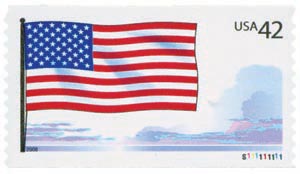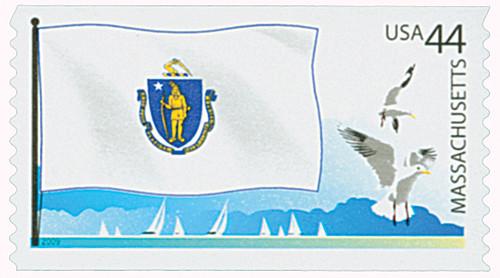
# 4293-4302 - 2009 44c Flags of Our Nation: 3rd Edition
Over 150 years later, the Kentucky Historical Society hired art teacher Jessie Cox Burgess to design the state flag. Emblazoned on the flag was the state motto, “United We Stand, Divided We Fall.” The motto came from the lyrics of an American Revolutionary War song and forever reminds people of the brave settlers of Kentucky.
The pelicans on the Louisiana state flag symbolize the waterways and harbors, which are the state’s lifeblood. The Mississippi, for which Iberville searched, empties into the Gulf of Mexico at New Orleans. In Colonial times, traders and fur trappers traveled the river by canoe. By the 1800s, paddle-wheel steamboats carried cotton south to New Orleans and Baton Rouge for shipment throughout the world. Louisiana became a center for trade, and by 1840, New Orleans was the wealthiest city in the nation. By the mid-19th century, Louisiana became a starting point for western settlement. Immigrants traveled north on the Mississippi to meet wagon trains to California and Oregon.
Maine’s first state flag was adopted in 1901 and pictured a pine tree and polar star on a field of beige. Eight years later, Maine adopted the current state flag, which shows the state seal on a field of blue. Both flags feature the majestic white pine tree.
Maryland is the only state whose flag bears the arms of an English Lord. The colony’s founder, George Calvert, adopted a coat of arms that included his father’s yellow and black colors and his mother’s white and red colors. The first Maryland flag only displayed the yellow and black checks. Although it was never officially adopted, the flag was widely accepted and quickly identified with Maryland. In 1861, the Civil War started and Maryland’s loyalties were divided. Virginia was a major trade partner and many sympathized with its cause. At the same time, the state bordered Washington, D.C., and it was once part of Maryland. Thousands of sympathizers crossed into Virginia and joined the Confederacy. To identify themselves as Confederate-Marylanders, they carried flags that included both colors. After the war, the process of reconciliation began. Maryland’s 5th Regiment was made up of men who fought on opposing sides during the war. It adopted the flag with both colors to show that Yankees and Rebels could work together again. The flag became a symbol of the state. In 1904, the flag was officially adopted as the Maryland state flag.
In 1915, the flag of Massachusetts was officially unfurled. Written on it was the motto, “By the sword we seek peace, but peace only under liberty.” The motto was adopted by Massachusetts Provincial Congress in 1775 – the same year that the “shot heard round the world” was fired. Although the current version of the flag was not ratified until 1971, the motto has embodied the spirit of Massachusetts for over 200 years.
Very different from Michigan’s current flag, the state’s first flag pictured a man – Michigan’s first governor, Stevens Thomson Mason. In 1865, his portrait was replaced with the U.S. coat of arms. The current flag, bearing the Michigan coat of arms, was officially adopted in 1911. Written on it is the phrase, “If you seek a pleasant peninsula, look about you.” Michigan is the only state consisting completely of two peninsulas.
It was 1893 and Minnesota was without a state flag. Each of the 44 states was invited to enter an exhibit at the Chicago World’s Fair – a flag was needed right away. The Minnesota Women’s Auxiliary sponsored a flag design contest – awarding Amelia Hyde Center $15 for her prize-winning design. Norwegian immigrants Pauline and Thomane Fjelde stitched the first flag. Featured on the original design, and still on the flag today, is a farmer plowing a field near the Mississippi River, with his axe in a tree stump. These images symbolize three resources that were vital to the state’s development – grain, water, and timber.
Early in 1861, Mississippi seceded from the U.S. and declared itself the Sovereign Republic of Mississippi. Mississippi was an independent nation for two months before the Confederate States of America was formed. The new republic adopted the Magnolia Flag, and continued to fly it after joining the Confederacy. In 1894, the current state flag was approved by the Mississippi State Legislature. Reflecting Mississippi’s Southern heritage, the flag included the Confederate Cross.
In 1908, the Missouri chapter of the Daughters of the American Revolution realized that Missouri had no state flag. They formed a committee to design the official flag of Missouri. Committee chairwoman Marie Oliver eventually designed the flag herself, centering the state seal on a field of red, white, and blue. On either side of the Missouri seal, harkening back to the days of Lewis and Clark, are two huge grizzly bears.
In 1893, Katharine Lee Bates traveled west to Colorado. As Bates approached Colorado Springs, she was awestruck at how the Pikes Peak granite gave the mountains a purple hue. As she stood on top of those “purple mountains” and looked down on the endless fields of grain, a poem came to mind. The ode to America’s natural beauty was praised by all who read it. An adaptation of her poem was put to hymn music and titled “America the Beautiful.”
The Flags Of Our Nation Series
The state flags had been honored on US stamps once before, in 1976 as part of the Bicentennial Series (US #1633-82). Those stamps marked an important first – they were America’s first 50-stamp se-tenant. The sheet featured all of the state flags in the order the states were admitted to the Union.
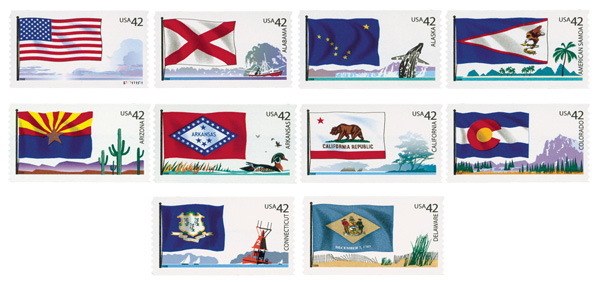
In 2008, the USPS again decided to honor the state flags but in a different format. These stamps represented a US postal first. They have the beauty and historic significance of commemorative stamps, but were issued as se-tenant (face-different attached) definitive coil stamps.
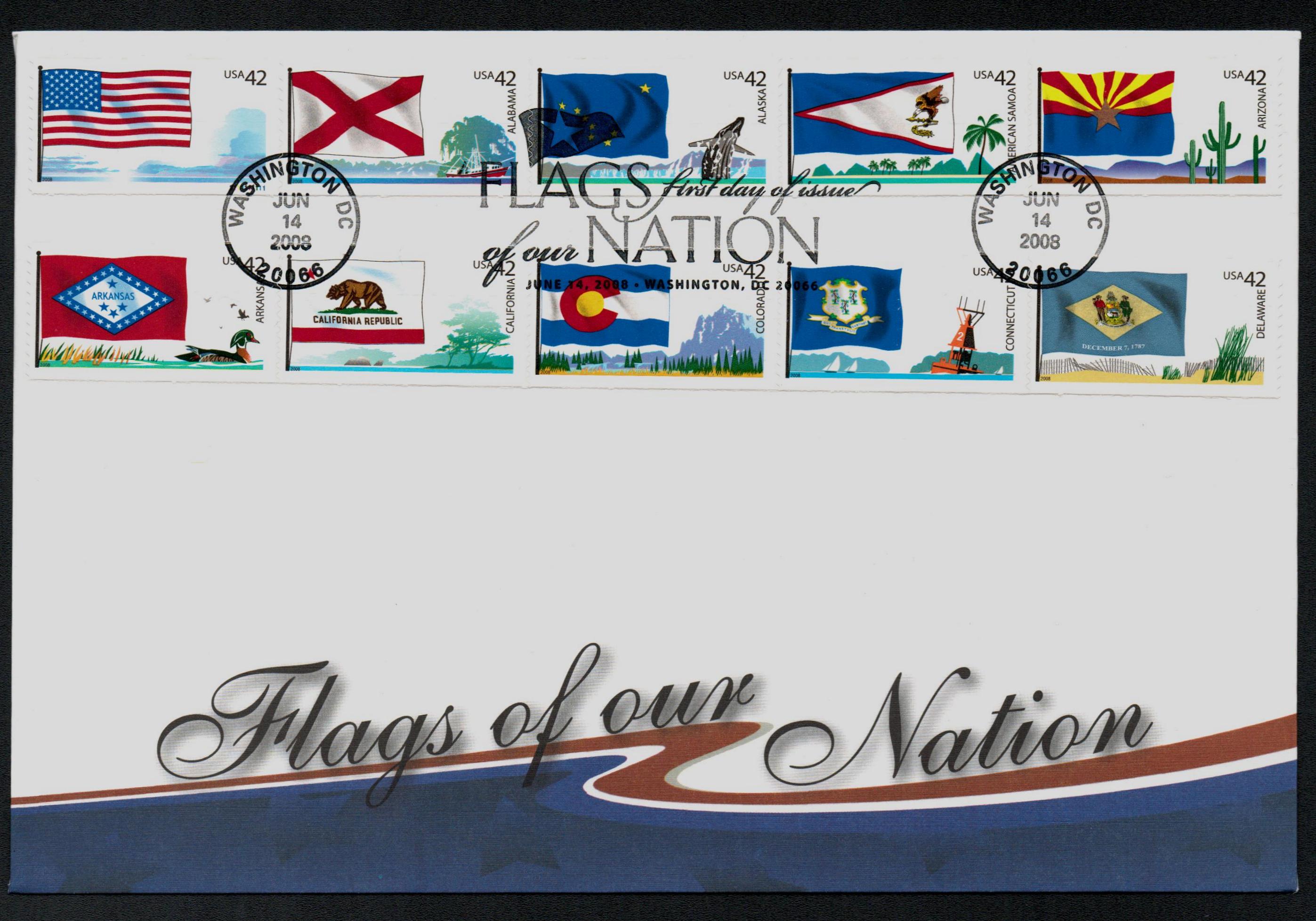
The new series was called “Flags of Our Nation” and would consist of 60 stamps total – 50 featuring state flags, five territorial flags, the District of Columbia flag, and four US flags flying over American landscapes described in “America the Beautiful.” The stamps in the new set would be issued in alphabetical order by state or territory. Each stamp would feature a flag and a “snapshot” from the state or territory. These snapshots would include scenic areas, plants, animals, and more.
The first set of stamps was issued on Flag Day, June 14, 2008 at the National Postal Museum in Washington, DC. It featured the flags of Alabama through Delaware, American Samoa, and the American flag with “spacious skies.”
In speaking about the stamps, a USPS representative said, “Flags are our nation’s greatest symbols for unity and pride and the values we hold dear. The Postal Service is proud to present this tribute as we honor our nation’s flags.” That same day, special events were held in the nine state capitals whose flags were featured in that first set of stamps.

The second set in the series was issued later in 2008, on September 2. As with the first set, there were special ceremonies in the state capitols of those states featured on this set of stamps. The stamps in this set featured the flags of Florida through Kansas, the District of Columbia and Guam.

Initially, two sets of 10 stamps were supposed to be issued each year for three years. However, in 2009 it was decided that each year would only include the issue of one set of 10 stamps. The third set was issued on August 6, 2009 at the American Philatelic Society Stamp Show in Pittsburgh, Pennsylvania. These stamps featured the flags of Kentucky through Missouri as well as the US flag with “amber waves of grain.”
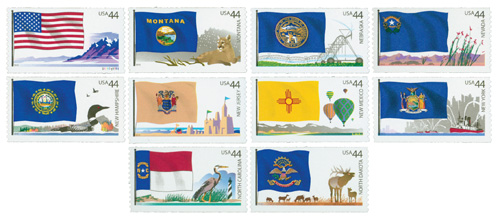
The fourth issue in the series was released on April 16, 2010 at the Mega Stamp Show in New York City. These stamps featured the flags of Montana through North Dakota with the US flag above “purple mountain majesties.”
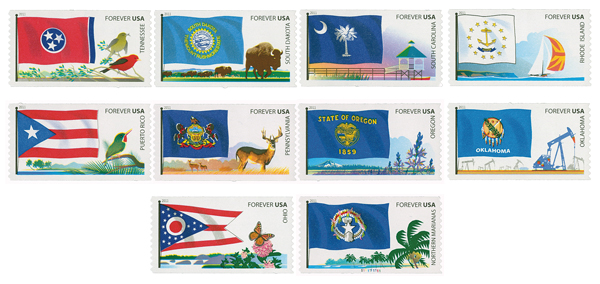
The fifth set was issued on August 11, 2011, at the American Philatelic Society Stamp Show, in Columbus Ohio. These were the first in the series to be issued as Forever stamps. Featured on these stamps were the flags of Ohio through Tennessee, Puerto Rico, and the Northern Mariana Islands.
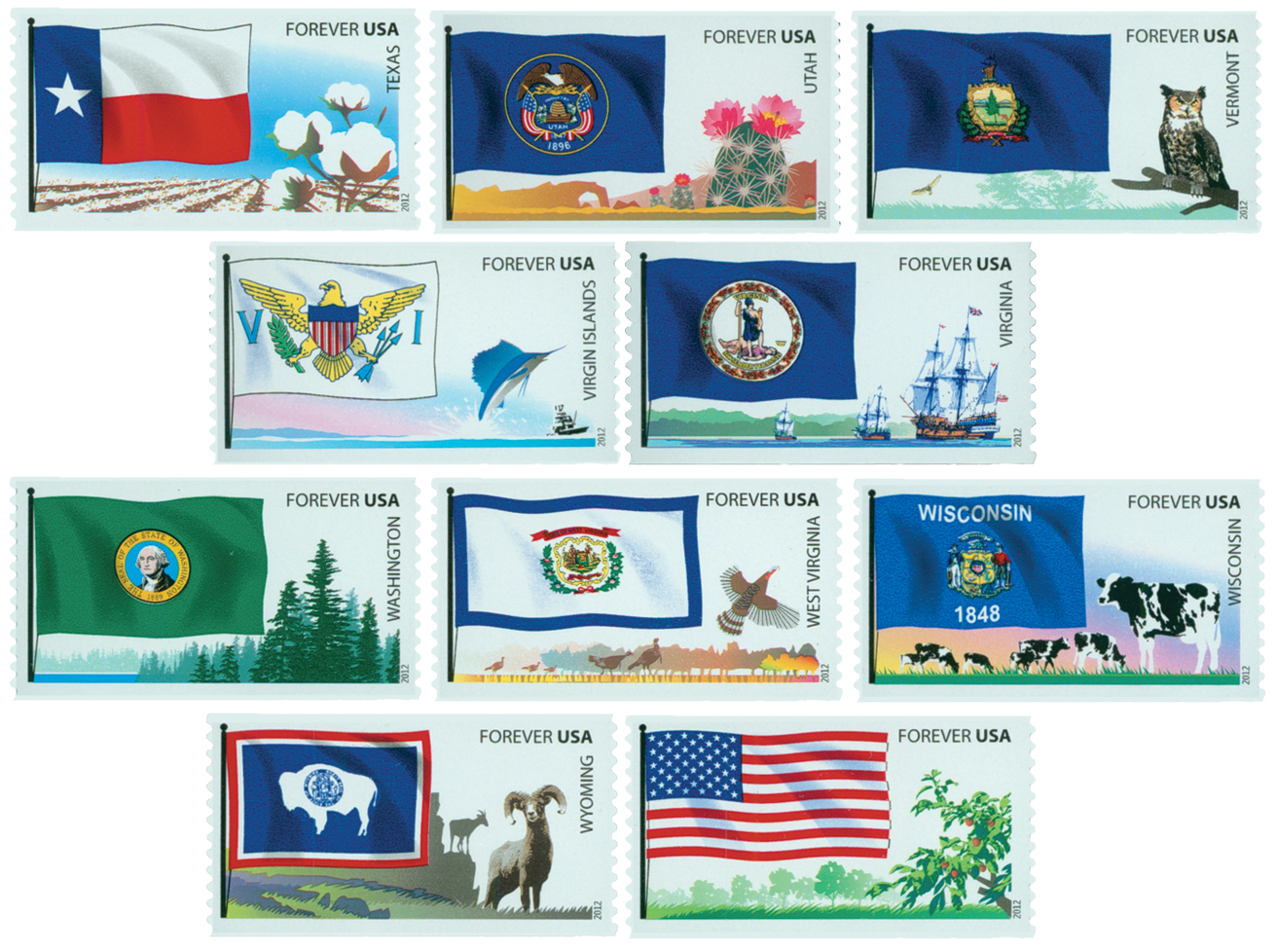
The series came to a close on August 16, 2012, with the sixth and final set. These stamps were issued at the American Philatelic Society Stamp Show in Sacramento, California. Featured on these stamps were the flags of Texas through Wyoming, the Virgin Islands, and the US flag with “the fruited plain.”
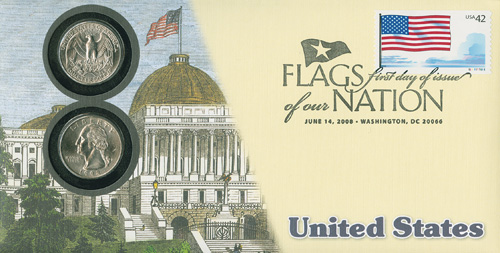
Click here for more Flags of Our Nation Coin Covers as well as single stamps and sets.
Click here to get the complete set of 60 Flags of Our Nation stamps in one convenient set.
Over 150 years later, the Kentucky Historical Society hired art teacher Jessie Cox Burgess to design the state flag. Emblazoned on the flag was the state motto, “United We Stand, Divided We Fall.” The motto came from the lyrics of an American Revolutionary War song and forever reminds people of the brave settlers of Kentucky.
The pelicans on the Louisiana state flag symbolize the waterways and harbors, which are the state’s lifeblood. The Mississippi, for which Iberville searched, empties into the Gulf of Mexico at New Orleans. In Colonial times, traders and fur trappers traveled the river by canoe. By the 1800s, paddle-wheel steamboats carried cotton south to New Orleans and Baton Rouge for shipment throughout the world. Louisiana became a center for trade, and by 1840, New Orleans was the wealthiest city in the nation. By the mid-19th century, Louisiana became a starting point for western settlement. Immigrants traveled north on the Mississippi to meet wagon trains to California and Oregon.
Maine’s first state flag was adopted in 1901 and pictured a pine tree and polar star on a field of beige. Eight years later, Maine adopted the current state flag, which shows the state seal on a field of blue. Both flags feature the majestic white pine tree.
Maryland is the only state whose flag bears the arms of an English Lord. The colony’s founder, George Calvert, adopted a coat of arms that included his father’s yellow and black colors and his mother’s white and red colors. The first Maryland flag only displayed the yellow and black checks. Although it was never officially adopted, the flag was widely accepted and quickly identified with Maryland. In 1861, the Civil War started and Maryland’s loyalties were divided. Virginia was a major trade partner and many sympathized with its cause. At the same time, the state bordered Washington, D.C., and it was once part of Maryland. Thousands of sympathizers crossed into Virginia and joined the Confederacy. To identify themselves as Confederate-Marylanders, they carried flags that included both colors. After the war, the process of reconciliation began. Maryland’s 5th Regiment was made up of men who fought on opposing sides during the war. It adopted the flag with both colors to show that Yankees and Rebels could work together again. The flag became a symbol of the state. In 1904, the flag was officially adopted as the Maryland state flag.
In 1915, the flag of Massachusetts was officially unfurled. Written on it was the motto, “By the sword we seek peace, but peace only under liberty.” The motto was adopted by Massachusetts Provincial Congress in 1775 – the same year that the “shot heard round the world” was fired. Although the current version of the flag was not ratified until 1971, the motto has embodied the spirit of Massachusetts for over 200 years.
Very different from Michigan’s current flag, the state’s first flag pictured a man – Michigan’s first governor, Stevens Thomson Mason. In 1865, his portrait was replaced with the U.S. coat of arms. The current flag, bearing the Michigan coat of arms, was officially adopted in 1911. Written on it is the phrase, “If you seek a pleasant peninsula, look about you.” Michigan is the only state consisting completely of two peninsulas.
It was 1893 and Minnesota was without a state flag. Each of the 44 states was invited to enter an exhibit at the Chicago World’s Fair – a flag was needed right away. The Minnesota Women’s Auxiliary sponsored a flag design contest – awarding Amelia Hyde Center $15 for her prize-winning design. Norwegian immigrants Pauline and Thomane Fjelde stitched the first flag. Featured on the original design, and still on the flag today, is a farmer plowing a field near the Mississippi River, with his axe in a tree stump. These images symbolize three resources that were vital to the state’s development – grain, water, and timber.
Early in 1861, Mississippi seceded from the U.S. and declared itself the Sovereign Republic of Mississippi. Mississippi was an independent nation for two months before the Confederate States of America was formed. The new republic adopted the Magnolia Flag, and continued to fly it after joining the Confederacy. In 1894, the current state flag was approved by the Mississippi State Legislature. Reflecting Mississippi’s Southern heritage, the flag included the Confederate Cross.
In 1908, the Missouri chapter of the Daughters of the American Revolution realized that Missouri had no state flag. They formed a committee to design the official flag of Missouri. Committee chairwoman Marie Oliver eventually designed the flag herself, centering the state seal on a field of red, white, and blue. On either side of the Missouri seal, harkening back to the days of Lewis and Clark, are two huge grizzly bears.
In 1893, Katharine Lee Bates traveled west to Colorado. As Bates approached Colorado Springs, she was awestruck at how the Pikes Peak granite gave the mountains a purple hue. As she stood on top of those “purple mountains” and looked down on the endless fields of grain, a poem came to mind. The ode to America’s natural beauty was praised by all who read it. An adaptation of her poem was put to hymn music and titled “America the Beautiful.”
The Flags Of Our Nation Series
The state flags had been honored on US stamps once before, in 1976 as part of the Bicentennial Series (US #1633-82). Those stamps marked an important first – they were America’s first 50-stamp se-tenant. The sheet featured all of the state flags in the order the states were admitted to the Union.

In 2008, the USPS again decided to honor the state flags but in a different format. These stamps represented a US postal first. They have the beauty and historic significance of commemorative stamps, but were issued as se-tenant (face-different attached) definitive coil stamps.

The new series was called “Flags of Our Nation” and would consist of 60 stamps total – 50 featuring state flags, five territorial flags, the District of Columbia flag, and four US flags flying over American landscapes described in “America the Beautiful.” The stamps in the new set would be issued in alphabetical order by state or territory. Each stamp would feature a flag and a “snapshot” from the state or territory. These snapshots would include scenic areas, plants, animals, and more.
The first set of stamps was issued on Flag Day, June 14, 2008 at the National Postal Museum in Washington, DC. It featured the flags of Alabama through Delaware, American Samoa, and the American flag with “spacious skies.”
In speaking about the stamps, a USPS representative said, “Flags are our nation’s greatest symbols for unity and pride and the values we hold dear. The Postal Service is proud to present this tribute as we honor our nation’s flags.” That same day, special events were held in the nine state capitals whose flags were featured in that first set of stamps.

The second set in the series was issued later in 2008, on September 2. As with the first set, there were special ceremonies in the state capitols of those states featured on this set of stamps. The stamps in this set featured the flags of Florida through Kansas, the District of Columbia and Guam.

Initially, two sets of 10 stamps were supposed to be issued each year for three years. However, in 2009 it was decided that each year would only include the issue of one set of 10 stamps. The third set was issued on August 6, 2009 at the American Philatelic Society Stamp Show in Pittsburgh, Pennsylvania. These stamps featured the flags of Kentucky through Missouri as well as the US flag with “amber waves of grain.”

The fourth issue in the series was released on April 16, 2010 at the Mega Stamp Show in New York City. These stamps featured the flags of Montana through North Dakota with the US flag above “purple mountain majesties.”

The fifth set was issued on August 11, 2011, at the American Philatelic Society Stamp Show, in Columbus Ohio. These were the first in the series to be issued as Forever stamps. Featured on these stamps were the flags of Ohio through Tennessee, Puerto Rico, and the Northern Mariana Islands.

The series came to a close on August 16, 2012, with the sixth and final set. These stamps were issued at the American Philatelic Society Stamp Show in Sacramento, California. Featured on these stamps were the flags of Texas through Wyoming, the Virgin Islands, and the US flag with “the fruited plain.”

Click here for more Flags of Our Nation Coin Covers as well as single stamps and sets.
Click here to get the complete set of 60 Flags of Our Nation stamps in one convenient set.






